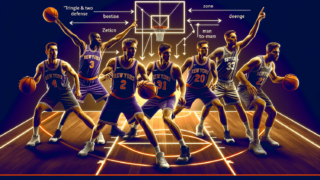
What’s a Diamond and Two Defense in Basketball?
Written by: Basketball Universe
Last updated:

Have you ever stumbled upon a strange term in the basketball world and wondered what on earth it meant? Well, look no further, because you’re in for an intriguing journey into the depths of basketball tactics! This time, we’ll be breaking down the mystery behind the “Diamond and Two Defense” in basketball, an ingenious strategy that keeps opponents guessing and can turn the tide of the game in the blink of an eye. So, fasten your high-top sneakers and let’s dive into this riveting topic as we explore the ins and outs of one of basketball’s lesser-known defensive gems!
What’s a Diamond and Two Defense in Basketball?
The Diamond and Two Defense is a combination defensive strategy in basketball, utilizing elements of both zone and man-to-man defenses. It consists of four players arranged in a diamond formation, with one player defending the top of the key, two players covering the wings, and one player defending underneath the basket. Meanwhile, the remaining two defenders are assigned to guard the opponent’s top offensive threats, playing tight man-to-man coverage on them. This approach allows the defense to effectively neutralize key players, while the other defenders ensure that the rest of the court remains well-protected.
Unraveling the Diamond Formation
Before diving deep into the Diamond and Two Defense, it is essential to understand the diamond formation’s positioning and responsibilities. Let’s break down each player’s role in this unique setup:
The Top of the Key Defender
This defender, typically a guard with quick foot speed, focuses on applying pressure to the ball-handler and preventing any easy penetration. The player’s primary goal is to force the opponent to move laterally, making it more challenging for them to create scoring opportunities. Additionally, the top defender denies any easy passes, especially entry passes to the low post or high post, and effectively communicates with their teammates to maintain the defensive structure.
The Wing Defenders
Positioned on both sides of the free-throw line extended, these two defenders are tasked with defending the perimeter, closing out on shooters, and denying any lane penetration. They also play a crucial role in preventing the ball from being passed into the low post. Wing defenders should possess good agility and athleticism to deter opponents from creating quick shots or effective drives to the basket.
The Low Post Defender
This player, typically a center or a power forward, is responsible for clogging the paint and acting as the last line of defense. Their priority is to provide help defense on any penetration that comes their way while also protecting the rim from easy layups, dunks, and grabbing any rebounds that present themselves.
Man-to-Man Coverage: Stopping the Star Players
Now that we’ve outlined the diamond formation, it’s time to address the other two defenders’ responsibilities within the Diamond and Two Defense. These players will closely guard the opposing team’s top-scoring threats, employing a tenacious man-to-man coverage that aims to limit their offensive output. The essential elements of this aspect of the defense are:
Denying and Deflecting Passes
One of the primary goals for these locked-in defenders is to deny their assignments any easy touches or passes that could lead to a shot or a scoring opportunity. By successfully doing this, they force the remaining offensive players to carry the scoring load, which can inhibit the opposing team’s offensive flow.
Fighting Through Screens
Elite scorers often rely on screens set by their teammates to create open shots. However, when executing the Diamond and Two Defense, the man-to-man defenders must fight through these screens, maintaining constant pressure on their assignments, and not allowing them any breathing room.
Adjusting to the Offense’s Countermeasures
As the game progresses, the offense may change its strategy to exploit any perceived weaknesses in the Diamond and Two Defense. The man-to-man defenders must be ready to adjust to these changes, effectively communicating with their teammates to maintain the defensive structure.’
Strengths of the Diamond and Two Defense
Like any defensive strategy in basketball, the Diamond and Two Defense provides several key advantages. Some of the most notable strengths of this defense are:
Neutralizing Key Offensive Threats
Assigning two defenders to shadow the opponents’ top threats can significantly impact their offensive efficiency, limiting their scoring and playmaking abilities. By denying them easy shots or drives and applying continuous pressure, the Diamond and Two Defense makes it increasingly difficult for the attacking team’s star players to make a meaningful impact on the game.
Forcing Role Players to Step Up
With the top threats contained, the Diamond and Two Defense forces the opposing team’s role players to carry a more substantial burden of the offensive responsibilities. This strategy can be particularly useful against teams with a significant drop-off in talent after their primary scoring threats.
Disrupting Offensive Rhythm
The mix of zone and man-to-man defensive principles within the Diamond and Two Defense can be challenging for offenses to decode, causing confusion and indecisiveness. This disruption can benefit the defense, as it may force opposing players into poor shot selection or turnovers.
Weaknesses of the Diamond and Two Defense
While the Diamond and Two Defense certainly provides several advantages, it is not without its vulnerabilities. Some of the most notable weaknesses of this defense are:
Susceptible to Perimeter Shooting
In the Diamond and Two Defense, there is a natural gap in coverage along the three-point line. Sharpshooters and proficient outside shooters can exploit this gap to create open shots beyond the arc. If the opponents have a team full of skilled shooters, running this defense might be less effective.
Less Rebounding Coverage
Because two defenders are continuously focused on the opponent’s offensive stars, they can often be pulled away from the basket, leaving the remaining defenders at a rebounding disadvantage. This weakness could lead to offensive rebound opportunities and put-backs for the opposing team, undermining the defense’s overall effectiveness.
Dependence on Effective Communication
The Diamond and Two Defense calls for constant communication among players, especially when adjusting to offensive countermeasures. Miscommunication, failure to switch or rotate properly, or a lack of adequate help from teammates can expose vulnerabilities, making it crucial for defenders to maintain accurate and timely communication throughout the game.
Implementing the Diamond and Two Defense: Drills and Tips
Are you ready to add the Diamond and Two Defense to your team’s arsenal? Integrating this innovative defensive scheme into your game plan requires practice, discipline, and good communication skills. Here are some drills and tips to help you become proficient in running the Diamond and Two Defense:
The Shell Drill
For the diamond formation, a great way to start is by practicing the shell drill, which emphasizes proper positioning and defensive rotations. With this exercise, players learn how to react to ball movement, close out on shooters, and recover into their defensive spots.
Dedicated Man-to-Man Drills
Given the significance of containing the opponent’s star players, intensive man-to-man defense should be practiced individually. Focus on various elements such as staying low on defense, fighting through screens, denying passes, recovering quickly, and providing adequate help when necessary.
Defensive Communication Exercises
Simple drills that promote communication, such as calling out when the ball is passed or when a screen is being set, can help develop a sense of trust and accountability among players. Practice calling out switches, rotations, and coverage adjustments to keep the whole team on the same page.
Simulated Game Situations
To effectively integrate the Diamond and Two Defense into your team’s system, it’s essential to practice it in simulated game situations. Incorporating it into scrimmages or live play enables players to identify potential problems, make adjustments, and become comfortable running the defense against different types of offenses.
Understanding Opponent Matchups and Game Flow
As with any basketball strategy, the Diamond and Two Defense is one of many tools that a team can employ in their pursuit of victory. The key to utilizing this defense effectively is to understand when to implement it and how it can best exploit the opponents’ weaknesses. Factors to consider when deciding if the Diamond and Two Defense is the right choice for your team include:
Offensive Reliance on Top Scorers
If the opposition’s offense heavily depends on one or two players to generate points, employing the Diamond and Two Defense may disrupt their offensive flow and force them to rely on less capable teammates to produce.
Perimeter Shooting of the Opposing Team
If the opponents lack accurate perimeter shooters, the Diamond and Two Defense can be a viable option, as the gaps in three-point coverage may not be as easily exploited by the attacking team.
Game Situation and Momentum
Using the Diamond and Two Defense in specific in-game situations, such as when momentum has shifted in the opponent’s favor, can help disrupt their rhythm and swing the game in your team’s favor.
In conclusion, the Diamond and Two Defense is a fascinating mix of zone and man-to-man coverage that can potentially stifle even the most potent offensive threats in basketball. Armed with a deeper understanding of this versatile defensive scheme, you are now one step closer to mastering the intricacies of this beautiful game!
Defensive Strategy Variations
While the Diamond and Two Defense is a highly innovative and effective defensive scheme, there are several variations and related strategies worth considering. Understanding these alternatives to the Diamond and Two Defense can help you better adjust your team’s game plan based on your opponents’ strengths and weaknesses. Let’s explore some of these intriguing strategies:
Box-and-One Defense
Similar to the Diamond and Two Defense, the Box-and-One Defense combines zone and man-to-man principles but employs a different arrangement of players. In this defensive scheme, four players set up in a box formation (two in the upper block and two in the lower block), while one primary defender is assigned with the task of relentlessly shadowing the opponent’s top scoring threat. This approach can be highly effective in neutralizing one superstar while giving the comfort of zone to the remaining players.
Triangle-and-Two Defense
The Triangle-and-Two Defense is another hybrid system that modifies the player arrangement and responsibilities within the zone. In this setup, three players form a triangle with one defender near the free-throw line, and two others protect the corners of the shaded area (paint). The remaining two defenders play man-to-man coverage against the opponent’s primary scoring threats. This defense adds a layer of complexity for the offense while maintaining the integrity of the zone and strong, man-to-man coverage against top-tier opponents.
Match-Up Zone Defense
The Match-Up Zone Defense is a versatile defensive scheme that incorporates both zone and man-to-man principles, requiring players to communicate and switch assignments based on the movement of their opponents within their area. While it may seem complex, this defense allows a team to adjust and adapt to the opponents’ offensive sets and maintain strong coverage throughout the game. Executing this defensive system requires a high level of discipline, teamwork, and communication, but can be highly disruptive for the opposing team.
Creating Turnovers and Transition Offense Opportunities
One of the primary objectives of a successful defense in basketball is to generate turnovers and create transition offense opportunities. Whether you are running the Diamond and Two Defense, Box-and-One, Triangle-and-Two, or a Match-Up Zone, here are some tips to help your team capitalize on your defensive prowess:
Active Hands and Deflections
Regardless of the specific defensive scheme being used, players should constantly maintain active hands, looking to deflect passes or disrupt dribblers. These deflections can lead to turnovers, giving your team the chance to push the pace offensively and create fast-break opportunities.
Forced Turnovers and Trapping
While executing any defense, finding opportunities to trap a ball-handler or force a turnover can shift the momentum in your team’s favor quickly. Encourage your players to recognize situations where they can double-team a dribbler or interfere in a passing lane effectively, leading to increased turnover chances and fast-break points.
Rebounding and Outlet Passes
To ignite a fast-paced transition offense, it’s critical for your team to secure defensive rebounds and make quick outlet passes. Provide your players with the necessary training and tools to become effective rebounders and outlet passers. When a player secures a defensive rebound, they should immediately look to pass the ball to an open teammate, ideally one who is ready to start the break and push the pace toward the opponent’s basket.
As you further explore the world of basketball defense, remember that the key to success lies in the ability to adapt and adjust to various offensive styles, situations, and matchups. By understanding the intricacies of the Diamond and Two Defense and its many variations, you are well on your way to becoming a more tactically-minded basketball enthusiast!
Frequently Asked Questions (FAQ)
Do you have questions about the Diamond and Two Defense strategy or related basketball topics? You’re not alone! We’ve compiled a list of frequently asked questions to provide quick, informative answers to help you better understand this unique defensive strategy and other related concepts. Check out the FAQs below for more insight:
1. When is the best time to implement the Diamond and Two Defense?
The ideal time to implement the Diamond and Two Defense is when the opposing team relies heavily on one or two top scorers. This strategy can also be useful during specific in-game situations, such as when momentum has shifted in the opponents’ favor, to disrupt their rhythm and regain control.
2. How effective is the Diamond and Two Defense against a team of sharpshooters?
The Diamond and Two Defense can be vulnerable to teams with multiple proficient shooters from beyond the arc, as there are gaps in three-point line coverage. In such scenarios, a more traditional zone defense or a match-up zone defense might be more effective.
3. What kind of players are best suited for the Diamond and Two Defense?
Players who excel in one-on-one defense, possess quick foot speed, and strong communication skills are well-suited for the Diamond and Two Defense. Athletic players with versatility in defending both the perimeter and interior are also highly valuable in this defensive scheme.
4. Can the Diamond and Two Defense be employed for an entire game?
While it is possible to use the Diamond and Two Defense throughout an entire game, it is often more effective when employed strategically to exploit specific weaknesses in the opposing team or in response to specific game situations.
5. How does the Diamond and Two Defense compare to the Box-and-One Defense?
Both the Diamond and Two Defense and the Box-and-One Defense share the concept of combining zone and man-to-man principles. However, the primary difference lies in the formation, with a diamond setup in the former and a box arrangement in the latter. Furthermore, the Diamond and Two Defense assigns two defenders to the opponents’ top scoring threats, whereas the Box-and-One focuses on neutralizing just one primary scorer.
6. Can the Diamond and Two Defense be adapted based on the offense’s adjustments?
Yes, the Diamond and Two Defense can be adapted and adjusted to counter various offensive strategies. This may involve tweaking player assignments, switching between man-to-man and zone coverage, or employing traps and double-teams to generate turnovers.
7. What drills can help players practice the Diamond and Two Defense?
To practice the Diamond and Two Defense, players can engage in the shell drill, dedicated man-to-man exercises, defensive communication exercises, and simulated game situations during practice sessions.
8. What offensive strategies can counter the Diamond and Two Defense?
Offensive strategies that can successfully counter the Diamond and Two Defense include quick ball movement, running multiple off-ball screens, utilizing off-the-dribble penetration, and shooting proficiency from long-range to exploit the gaps in three-point line coverage.
9. How does the Triangle-and-Two Defense differ from the Diamond and Two Defense?
Both the Triangle-and-Two Defense and the Diamond and Two Defense combine zone and man-to-man principles. The key difference lies in the players’ arrangement, with a triangular setup in the former and a diamond formation in the latter.
10. What are the main principles of the Match-Up Zone Defense?
The Match-Up Zone Defense is a hybrid system that blends zone and man-to-man defensive principles. In this scheme, players are responsible for guarding specific areas of the court, while also maintaining the ability to switch between man-to-man and zone assignments based on the offense’s movement.
11. How can a team capitalize on a successful Diamond and Two Defense?
Teams can capitalize on a successful Diamond and Two Defense by generating turnovers, leading to transition offense opportunities through active hands, deflections, forced turnovers, and trapping, while also focusing on securing defensive rebounds and making quick outlet passes.
12. Why is communication vital in the Diamond and Two Defense?
Effective communication is crucial in the Diamond and Two Defense, as the players involved in man-to-man coverage need to coordinate with their teammates in the zone to avoid any mismatches or defensive breakdowns. Proper communication ensures accurate and timely switching, rotation, and help defense.
13. Can the Diamond and Two Defense be used by inexperienced teams?
While understanding and executing the Diamond and Two Defense might be challenging initially, inexperienced teams can leverage this strategy by focusing on the fundamentals, including basic positioning, defensive rotations, and communication. As the team gains more experience, players can start incorporating advanced concepts into their defensive repertoire, eventually mastering the Diamond and Two Defense.
Featured Posts
- No pillar pages found.





